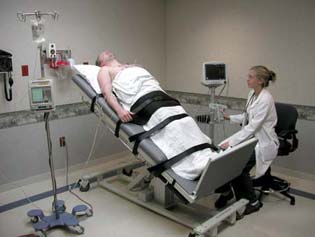Tilt Table Test
 This is a non-invasive test used to diagnose some conditions that can cause a patient to pass out. The test is conducted with the patient initially lying flat on the table, following which the table is slowly tilted upward. Blood pressure, heart rate, and EKG are monitored throughout the test.
This is a non-invasive test used to diagnose some conditions that can cause a patient to pass out. The test is conducted with the patient initially lying flat on the table, following which the table is slowly tilted upward. Blood pressure, heart rate, and EKG are monitored throughout the test.
How do I prepare for the test?
- DO NOT eat or drink anything for six to eight hours before the procedure.
- If you are taking medications, your physician will give you instructions if any changes are to be made in the doses.
- Some medications may be held (not taken) for two to three days before the procedure.
- You should make arrangements to have someone drive you home after the procedure, as you will most likely be told not to drive afterwards.
How Is the Test Performed?
To start the test, an IV will be inserted into a vein in your arm. A blood pressure cuff will be placed on each arm, and you will be connected to an EKG machine by electrodes that are placed on your chest. You will also be connected to a separate cardiac monitor and defibrillator. Safety straps will be placed around your legs, abdomen and chest to help secure you to the table. Your EKG and blood pressure will be monitored constantly during the procedure.
The table will be raised to an upright position of 70 degrees for 45 minutes. If no symptoms occur, the table is returned to a flat position. An adrenaline-like medication will be given through your IV to help induce syncope. The medication may cause an increase in your heart rate. You will then be tilted upright again for fifteen minutes. You will then be returned to a supine position and medication will be increased before returning to a final upright position for fifteen minutes. The table will then be returned to a flat position for a recovery period.
